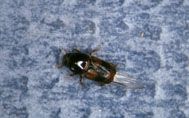Elm Bark Beetles
They look like little tanks with rust-colored armor that seems impenetrable. They’re elm bark beetles and if left unchecked, they could possibly destroy every elm tree in the United States.
There’s at least one bark beetle species on every state’s “Most Unwanted” invasive pest list and in some states, their presence calls for such drastic measures as removing and destroying any elm tree within five miles of a diseased tree.
Elm Bark Beetles Description
According to the U.S. Forest Service, “Three species of bark beetles are associated with elms in the United States.” The native elm bark beetle is  the lightest rust color of the three species and is typically found in the Great Lakes states, west to Nebraska and as far south as Alabama and Mississippi. The European elm bark beetle is a very dark brown and can be found throughout the United States. The banded elm beetle is brown with black bands and it made its way to the U.S. from Asia and is common in western states. All three species are working toward total domination of the country and it’s not uncommon to find more than one species in a geographical area.
the lightest rust color of the three species and is typically found in the Great Lakes states, west to Nebraska and as far south as Alabama and Mississippi. The European elm bark beetle is a very dark brown and can be found throughout the United States. The banded elm beetle is brown with black bands and it made its way to the U.S. from Asia and is common in western states. All three species are working toward total domination of the country and it’s not uncommon to find more than one species in a geographical area.
Each of the elm bark beetles causes damage when they bore into and out of trees as part of their life cycles. A healthy elm might withstand the damage caused by boring. However, it’s easier to bore into a diseased tree than a healthy tree so elm bark beetles often come in contact with Dutch elm disease. Larvae that hatch from a diseased tree carry the pathogen to other elms, speeding the spread of the disease.
Elm bark beetles and Dutch elm disease require immediate professional inspection. Call or contact Spraytech, Colorado tree health specialists, at 720-248-0000 to discuss control options.

